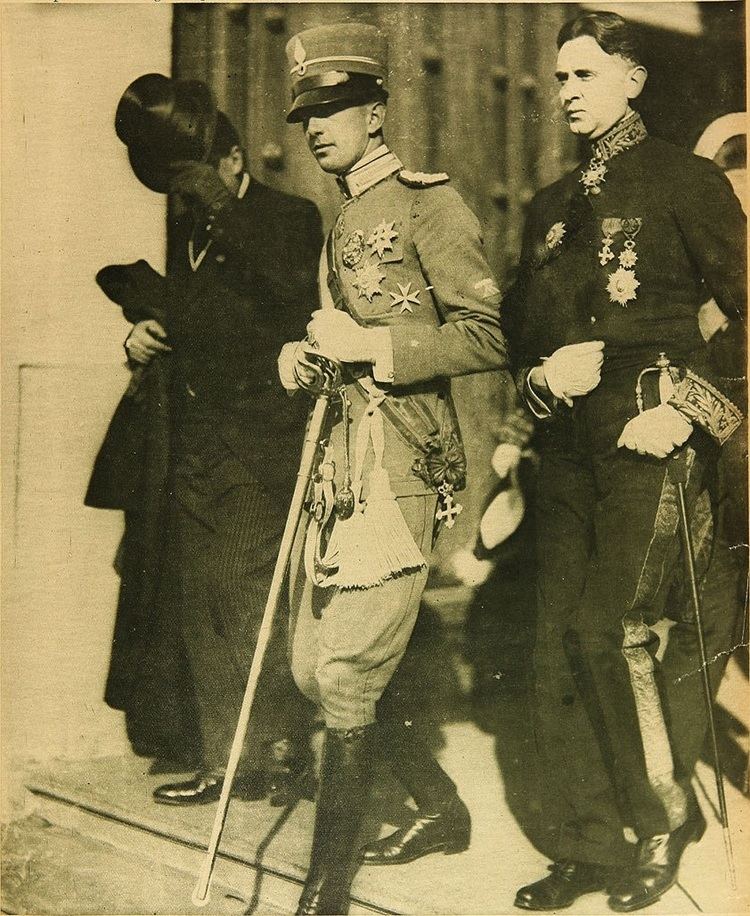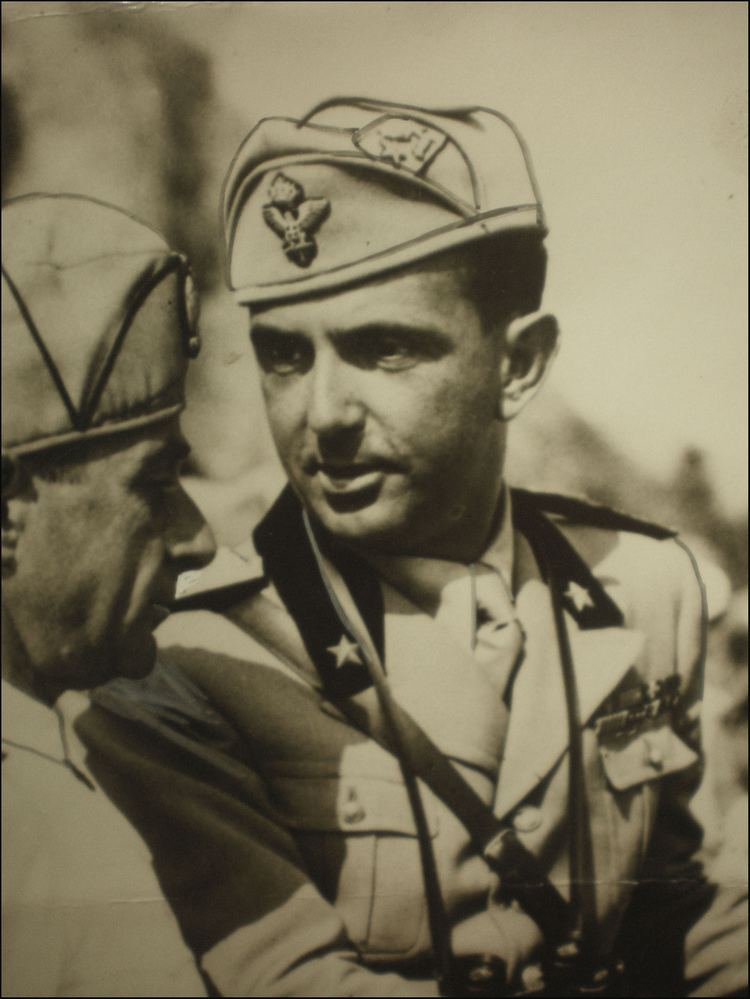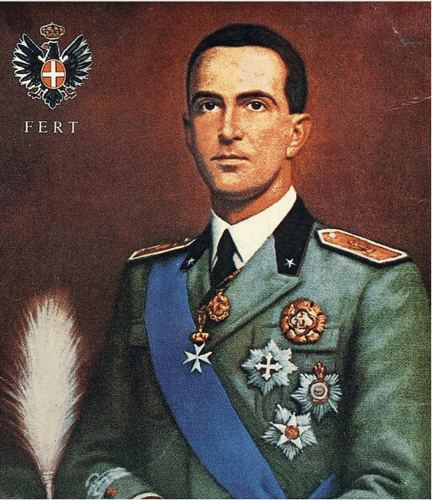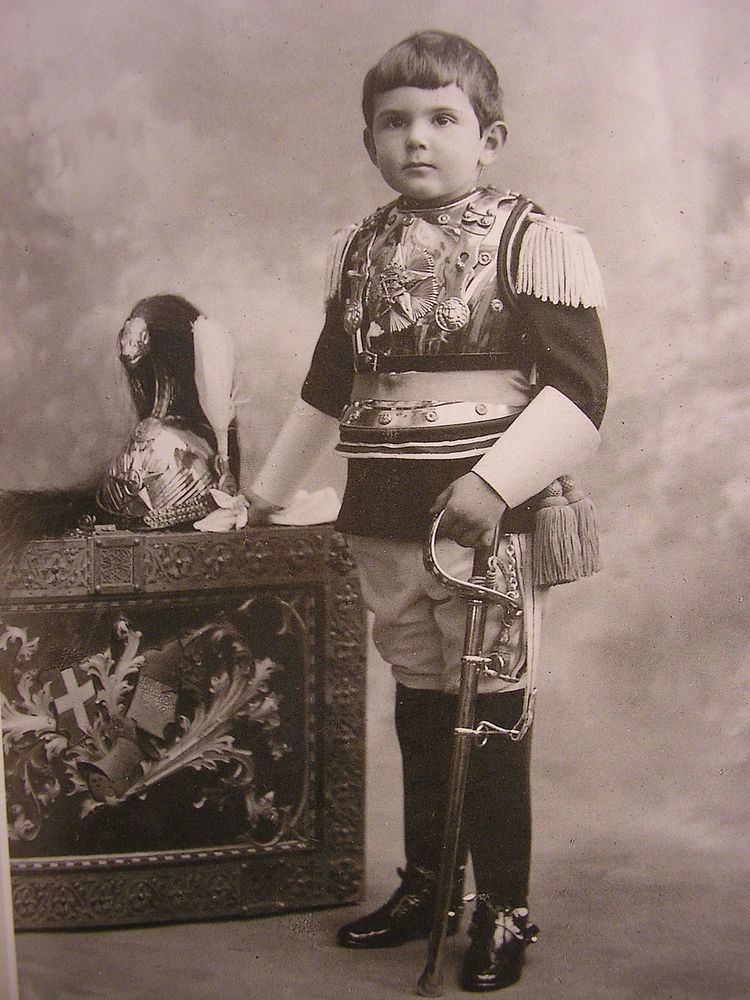Predecessor Victor Emmanuel III Name Umberto of | ||
 | ||
Reign 9 May 1946 – 12 June 1946 Born 15 September 1904Racconigi, Italy ( 1904-09-15 ) Spouse Marie Jose of Belgium (m. 1930) Children Vittorio Emanuele, Prince of Naples Parents Elena of Montenegro, Victor Emmanuel III of Italy Similar People Marie Jose of Belgium, Victor Emmanuel III of Italy, Vittorio Emanuele - Prince of, Umberto I of Italy, Princess Maria Gabriella | ||
maria jos of belgium umberto ii of italy
Umberto II (Italian: Umberto Nicola Tommaso Giovanni Maria di Savoia; 15 September 1904 – 18 March 1983), was the last King of Italy. He reigned for 34 days, from 9 May 1946 to 12 June 1946, although he had been de facto head of state since 1944, and was nicknamed the May King (Italian: Re di Maggio).
Contents
- maria jos of belgium umberto ii of italy
- Early life
- Marriage and issue
- State visit to South America 1924
- Military positions and attempted assassination
- Visit to Italian Somaliland
- During the Second World War
- Regency
- King of Italy
- Private life
- In exile
- Titles and styles
- National honours
- Foreign honours
- Patrilineal ancestry
- Additional reading
- References

Umberto was the only son of the five children of King Victor Emmanuel III and Queen Elena. In an effort to repair the monarchy's image after the fall of Benito Mussolini's regime, Victor Emmanuel transferred his powers to Umberto in 1944 while retaining the title of king. As a referendum was in preparation on the abolition of the monarchy in 1946, Victor Emmanuel abdicated his throne in favour of Umberto in the hope his exit might bolster the monarchy. However, the referendum passed, Italy was declared a republic, and Umberto lived out the rest of his life in exile in Cascais, Portugal.

Early life

Umberto was born at the Castle of Racconigi in Piedmont. He was the third child, and the only son, of King Victor Emmanuel III of Italy and his wife, Elena of Montenegro. As such, he became heir apparent upon his birth, since the Italian throne was limited to male-line descendants only. He was the first cousin of King Alexander I of Yugoslavia. He was accorded the title of Prince of Piedmont, which was formalised by Royal Decree on 29 September.
Marriage and issue

Umberto was married in Rome on 8 January 1932 to Marie José of Belgium (1906–2001), daughter of King Albert I of Belgium and his wife Queen Elisabeth, née Duchess Elisabeth in Bavaria.
They had four children:
State visit to South America, 1924
As Prince of Piedmont, Umberto visited South America, between July and September 1924. With his preceptor, Bonaldi, he went to Brazil, Uruguay, Argentina and Chile. This trip was part of the political plan of Fascism to link the Italian people living outside of Italy with their mother country and the interests of the regime.
Military positions and attempted assassination
The Prince of Piedmont was educated for a military career and in time became the commander in chief of the Northern Armies, and then of the Southern ones. However, his role was merely formal, the de facto command belonging to Benito Mussolini. By mutual agreement, Umberto and Mussolini always kept a distance.
An attempted assassination of the prince took place in Brussels on 24 October 1929, the day of the announcement of his betrothal to Princess Marie José. The prince was about to lay a wreath on the Tomb of the Belgian Unknown Soldier at the foot of the Colonne du Congrès. With a cry of 'Down with Mussolini!', the culprit, Fernando de Rosa, fired a single shot that missed the Prince of Piedmont.
De Rosa was arrested and, under interrogation, claimed to be a member of the Second International, who had fled Italy to avoid arrest for his political views. His trial became a major political event, and although he was found guilty of attempted murder, he was given a light sentence of five years in prison. This sentence caused a political uproar in Italy and a brief rift in Belgian-Italian relations. However, Prince Umberto himself in March 1932 took the step of asking for a pardon for his would-be assassin, who was released after having served slightly less than half of his sentence and was eventually killed in the Spanish Civil War.
Following the Savoyards' tradition ("Only one Savoy reigns at a time"), he kept apart from active politics until he was finally named Lieutenant General of the Realm. He made an exception when Adolf Hitler asked for a meeting. This action was not considered proper, given the international situation; thereafter Umberto was more rigorously excluded from political events.
Visit to Italian Somaliland
In 1928, after the colonial authorities in Italian Somaliland built the Mogadishu Cathedral (Cattedrale di Mogadiscio), Umberto made his first publicized visit to Mogadishu, the territory's capital. Umberto would make his second publicized visit to Italian Somaliland in October 1934.
During the Second World War
At the beginning of World War II, Umberto commanded Army Group West, made up of the First, Fourth and the Seventh Army (kept in reserve), which attacked French forces during the Italian invasion of France.
After the capitulation of France, Umberto was kept inactive as Army commander by Mussolini. Nevertheless, on 29 October 1942, he was awarded the rank of Marshal of Italy (Maresciallo d'Italia).
In 1943, the Crown Princess Marie José involved herself in vain attempts to arrange a separate peace treaty between Italy and the United States, and her interlocutor from the Vatican was Monsignor Giovanni Battista Montini, a senior diplomat who later became Pope Paul VI. Her attempts were not sponsored by the king and Umberto was not (directly, at least) involved in them. After her failure – she never met the American agents – she was sent with her children to Sarre, in Aosta Valley, and isolated from the political life of the Royal House.
Regency
As the Allies freed more and more of Italy from the Salò regime, it became apparent that Victor Emmanuel was too tainted by his previous support of Fascism to have any further role. Accordingly, in April 1944, he transferred most of his powers to Umberto. This status was formalized after Rome was liberated in June, when Victor Emmanuel transferred his remaining constitutional powers to Umberto, naming his son Lieutenant General of the Realm. However, Victor Emmanuel retained the title of King.
King of Italy
Umberto earned widespread praise for his role in the following three years. In hopes of influencing public opinion ahead of a referendum on the continuation of the monarchy, Victor Emmanuel formally abdicated in favour of Umberto on 9 May 1946.
Many Italian monarchists expressed doubts about the legitimacy of the referendum, claiming that millions of voters, many of them pro-monarchist, were unable to vote because they had not yet been able to return to their own local areas to register. Nor had the issue of Italy's borders been settled definitively, so the voting rights of those in disputed areas had not been satisfactorily clarified. Other allegations were made about voter manipulation, and even the issue of how to interpret the votes became controversial, as it appeared that not just a majority of those validly voting but of those votes cast (including spoiled votes), was needed to reach an outcome in the event the monarchy lost by a tight margin.
In the 2 June referendum, a decisive majority voted to make Italy a republic. The republic was formally proclaimed four days later, ending Umberto's brief 34-day reign as king. Many observers believe that had Victor Emmanuel abdicated sooner, the monarchy might have survived.
Having promised to accept the election results, Umberto accepted deposition, urging his now former subjects to serve the new republic. The monarchy of the House of Savoy formally ended on 12 June 1946, and Umberto left the country. Prime Minister Alcide de Gasperi assumed office as Italy's interim Head of State.
Private life
Umberto and Marie José separated in exile; it had been an arranged marriage, following a long tradition of royal families. However, they never divorced, partly for political reasons.
Some academics have speculated about Umberto's possible homosexuality. Certainly during the war, some newspapers alleged that Umberto was homosexual, and information continued to be spread in the lead-up to the post-war referendum on the monarchy in the hope of influencing the outcome. Umberto's custom of giving a fleur-de-lis made of precious stones to favoured young officials in his entourage was well known, and Umberto's lovers may have included Luchino Visconti and Jean Marais; there was a former army lieutenant who published details of Umberto's advances to him. Except for public appearances, Umberto and Marie José generally lived apart.
In exile
Umberto II lived for 37 years in exile, in Cascais, Portugal. He never set foot in his native land again; the 1948 constitution of the Italian Republic not only forbade amending the constitution to restore the monarchy, but until 2002 barred all male heirs to the defunct Italian throne from ever returning to Italian soil. Female members of the Savoy family were not barred, except queens consort.
He traveled extensively during exile, and was often to be seen in Mexico visiting his daughter Maria Beatrice.
At the time when Umberto was dying, in 1983, President Sandro Pertini wanted the Italian Parliament to allow Umberto to return to his native country. Ultimately, however, Umberto died in Geneva and was interred in Hautecombe Abbey, for centuries the burial place of the members of the House of Savoy. No representative of the Italian government attended his funeral.
Titles and styles
At birth, Umberto was granted the traditional title of Prince of Piedmont. This was formalised by Royal Decree on 29 September 1904.
National honours
Foreign honours
Patrilineal ancestry
- Humbert I of Savoy, 980–1047
- Otto of Savoy, 1015–1057
- Amadeus II of Savoy, 1039–1080
- Humbert II of Savoy, 1070–1103
- Amadeus III of Savoy, 1095–1148
- Humbert III of Savoy, 1135–1189
- Thomas I of Savoy, 1176–1233
- Thomas II, Count of Piedmont, 1199–1259
- Amadeus V, Count of Savoy, 1251–1323
- Aimone, Count of Savoy, 1291–1343
- Amadeus VI, Count of Savoy, 1334–1383
- Amadeus VII, Count of Savoy, 1360–1391
- Amadeus VIII, Duke of Savoy, 1383–1451
- Louis, Duke of Savoy, 1402–1465
- Philip II, Duke of Savoy, 1438–1497
- Charles III, Duke of Savoy, 1486–1553
- Emmanuel Philibert, Duke of Savoy, 1528–1580
- Charles Emmanuel I, Duke of Savoy, 1562–1630
- Thomas Francis, Prince of Carignano, 1596–1656
- Emmanuel Philibert, Prince of Carignano, 1628–1709
- Victor Amadeus I, Prince of Carignano, 1690–1741
- Louis Victor, Prince of Carignano, 1721–1778
- Victor Amadeus II, Prince of Carignano, 1743–1780
- Charles Emmanuel, Prince of Carignano, 1770–1800
- Charles Albert of Sardinia, 1798–1849
- Victor Emmanuel II of Italy, 1820–1878
- Umberto I of Italy, 1844–1900
- Victor Emmanuel III of Italy, 1869–1947
- Umberto II of Italy, 1904–1983
